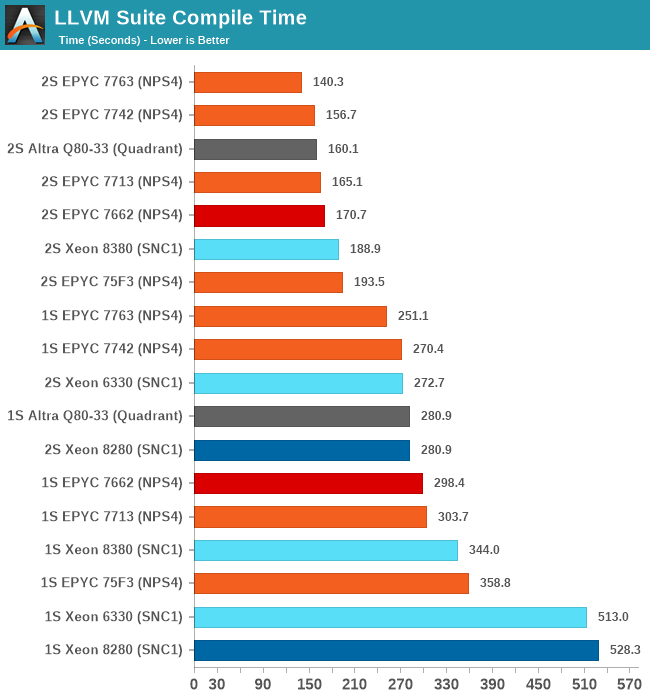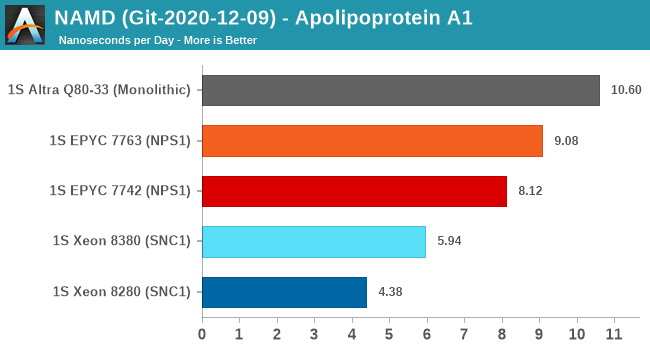Intel 3rd Gen Xeon Scalable (Ice Lake SP) Review: Generationally Big, Competitively Small
by Andrei Frumusanu on April 6, 2021 11:00 AM EST- Posted in
- Servers
- CPUs
- Intel
- Xeon
- Enterprise
- Xeon Scalable
- Ice Lake-SP
Compiling LLVM, NAMD Performance
As we’re trying to rebuild our server test suite piece by piece – and there’s still a lot of work go ahead to get a good representative “real world” set of workloads, one more highly desired benchmark amongst readers was a more realistic compilation suite. Chrome and LLVM codebases being the most requested, I landed on LLVM as it’s fairly easy to set up and straightforward.
git clone https://github.com/llvm/llvm-project.gitcd llvm-projectgit checkout release/11.xmkdir ./buildcd ..mkdir llvm-project-tmpfssudo mount -t tmpfs -o size=10G,mode=1777 tmpfs ./llvm-project-tmpfscp -r llvm-project/* llvm-project-tmpfscd ./llvm-project-tmpfs/buildcmake -G Ninja \ -DLLVM_ENABLE_PROJECTS="clang;libcxx;libcxxabi;lldb;compiler-rt;lld" \ -DCMAKE_BUILD_TYPE=Release ../llvmtime cmake --build .We’re using the LLVM 11.0.0 release as the build target version, and we’re compiling Clang, libc++abi, LLDB, Compiler-RT and LLD using GCC 10.2 (self-compiled). To avoid any concerns about I/O we’re building things on a ramdisk. We’re measuring the actual build time and don’t include the configuration phase as usually in the real world that doesn’t happen repeatedly.

Starting off with the Xeon 8380, we’re looking at large generational improvements for the new Ice Lake SP chip. A 33-35% improvement in compile time depending on whether we’re looking at 2S or 1S figures is enough to reposition Intel’s flagship CPU in the rankings by notable amounts, finally no longer lagging behind as drastically as some of the competition.
It’s definitely not sufficient to compete with AMD and Ampere, both showcasing figures that are still 25 and 15% ahead of the Xeon 8380.
The Xeon 6330 is falling in line with where we benchmarked it in previous tests, just slightly edging out the Xeon 8280 (6258R equivalent), meaning we’re seeing minor ISO-core ISO-power generational improvements (again I have to mention that the 6330 is half the price of a 6258R).

NAMD is a problem-child benchmark due to its recent addition of AVX512: the code had been contributed by Intel engineers – which isn’t exactly an issue in my view. The problem is that this is a new algorithm which has no relation to the normal code-path, which remains not as hand-optimised for AVX2, and further eyebrow raising is that it’s solely compatible with Intel’s ICC and no other compiler. That’s one level too much in terms of questionable status as a benchmark: are we benchmarking it as a general HPC-representative workload, or are we benchmarking it solely for the sake of NAMD and only NAMD performance?
We understand Intel is putting a lot of focus on these kinds of workloads that are hyper-optimised to run well extremely on Intel-only hardware, and it’s a valid optimisation path for many use-cases. I’m just questioning how representative it is of the wider market and workloads.
In any case, the GCC binaries of the test on the ApoA1 protein showcase significant performance uplifts for the Xeon 8380, showcasing a +35.6% gain. Using this apples-to-apples code path, it’s still quite behind the competition which scales the performance much higher thanks to more cores.










169 Comments
View All Comments
Shorty_ - Thursday, April 8, 2021 - link
did you read the article before commenting?I'm inclined to believe him-- I think yields are still an issue (which is why they have so many dark cores) and that getting enough chips to meet demand on the 40 core parts will be tough.
Hifihedgehog - Saturday, April 17, 2021 - link
LOL Gondalf. Who pays $1000 for your thoughts?DannyH246 - Tuesday, April 6, 2021 - link
Another Intel marketing presentation from www.IntelTech.comLet me summarize - slower, hotter, pricier than the AMD equivalent. Zero reason to buy.
SarahKerrigan - Tuesday, April 6, 2021 - link
"As impressive as the new Xeon 8380 is from a generational and technical stand-point, what really matters at the end of the day is how it fares up to the competition. I’ll be blunt here; nobody really expected the new ICL-SP parts to beat AMD or the new Arm competition – and it didn’t."How is that "Intel marketing"?
ParalLOL - Tuesday, April 6, 2021 - link
In this case you did not even need to read the article to know what the tone would be. I guess Danny did not manage to read the title either.fallaha56 - Tuesday, April 6, 2021 - link
how? the chip isn't worth touching with bargepolethat's if the 38-40 core parts are actually available
which they won't be
and what sysadmin is going to go demand this when Milan is a drop in replacement and Intel next-gen is an entirely new platform
Azix - Tuesday, April 6, 2021 - link
Are you assuming they won't be because semiaccurate said so? They have 100% track record? Didn't he also say Rocket Lake S wouldn't clock high at all?yeeeeman - Tuesday, April 6, 2021 - link
this ain't intel marketing presentation. This is a laid back, relaxed, non-biased and professional review. Not everyone hates Intel with their whole heart and not every reviewer hunts for clicks, so as to say that the new Intel server chip are shit. In the grand scheme of things, sure, they are not competitive, BUT Intel still has a few advantages over AMD that for some customers it might matter more than absolute performance.In the server space, price, dependability, upgradeability, quality and support is the name of the game. AMD, as we know even from consumer products isn't that amazing when it comes to drivers, BIOS quality and fixing bugs, whereas Intel is much more reliable in this regard. Sure, sure, you might say I am a fanboy, but first check what I say and then call me that if you want. Nevertheless, Intel needs Sapphire Rapids badly because even with all their advantages, they will keep losing marketshare.
fallaha56 - Tuesday, April 6, 2021 - link
absolute nonsense from a fanboi yesIntel is currently slower, buggier and overpriced with horrific security issues meaning you can have: slow and insecure or even slower and barely secure
and who ever thought servers would regularly need watercooling
also what on Earth are you talking about upgrades? this entire platform is getting chucked shortly while AMD has offered multiple generations on the same platform for years with an upgrade bringing DDR5 and PCIe 5
fallaha56 - Tuesday, April 6, 2021 - link
wonderfully summed up here:https://semiaccurate.com/2021/04/06/intels-ice-lak...